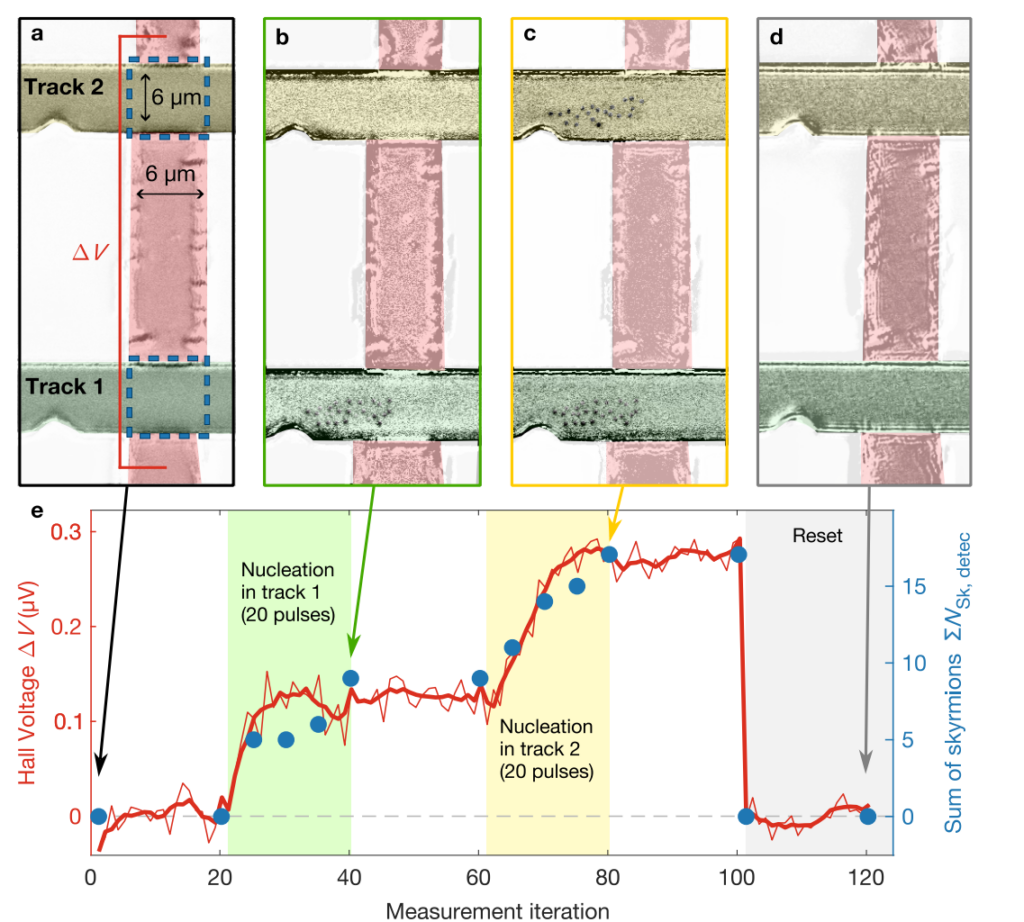[Scientific Result] Neuromorphic weighted sum with magnetic skyrmions
To meet the increasing demands of digital technology and the rapid rise of generative AI, researchers from the Albert Fert Laboratory are investigating magnetic skyrmions. Their study, “Neuromorphic weighted sum with magnetic skyrmions,” was published in Nature Electronics in 6 January 2025.
To address the exponential growth of digital objects and demands, one of the major challenges in the coming years will be to develop efficient, low-power components. This is particularly critical with the rise of generative Artificial Intelligence, which consumes significant amounts of energy, especially during the training phase. In this fundamental study, we leveraged the properties of magnetic skyrmions—analogous to biological neurotransmitters—to perform a core operation in neuromorphic computing: the weighted summation of synaptic signals. Magnetic skyrmions enable this operation to be executed in a compact and energy-efficient manner, paving the way for neuromorphic components that approach the efficiency of biological systems.
This research was conducted at the Albert Fert Laboratory in Palaiseau as part of the ERC Grenadyn project, the EU Pathfinder SKYANN project, and the CHIREX project under the PEPR SPIN program, supported by the France 2030 initiative.
In the article by T. Da Camara Santa Clara Gomes et al., published in Nature Electronics, the researchers demonstrate the ability to control the nucleation and current-induced motion of magnetic skyrmions, establishing a linear relationship between the number of current pulses and the number of skyrmions generated. These skyrmions, which are non-volatile magnetic topological entities, act as analogs to neurotransmitters in a neural network. The study shows how synaptic weights can be adjusted using a small magnetic field and employs the anomalous Hall effect to detect and sum skyrmions generated across multiple synapses of an artificial neuron. For the first time, the researchers experimentally validated the execution of a weighted summation in a proof-of-concept device comprising two synapses and one neuron, demonstrating the potential for compact and energy-efficient neuromorphic architectures.
The researchers present an experimental proof of concept for performing a weighted summation—a fundamental building block of neuromorphic architectures—using sub-micron magnetic skyrmions. They demonstrate an electrical method for controlling the nucleation and displacement of skyrmions in magnetic multilayer tracks, enabling the multiplication of input signals by a synaptic weight. This synaptic weight can be finely tuned through small adjustments to the external magnetic field, providing flexibility for neural network training.
Skyrmions generated by current pulses are detected and summed using the anomalous Hall effect, allowing the weighted summation operation to be executed in a single physical measurement without disrupting the skyrmion motion. The researchers validated this weighted summation in a device featuring two parallel tracks connected by transverse Hall electrodes, where the Hall voltage reflects the total number of skyrmions in the tracks. This approach achieves the basic operation of neural networks with enhanced energy efficiency and precision.
This device is designed to minimize current loss and disruptions in skyrmion motion by utilizing highly resistive tantalum (Ta) electrodes connected only to the edges of the magnetic tracks. By optimizing the parameters for skyrmion generation and motion, the researchers successfully injected several dozen skyrmions into a 6 µm-wide track, demonstrating the feasibility of performing neuromorphic operations on larger-scale networks.



